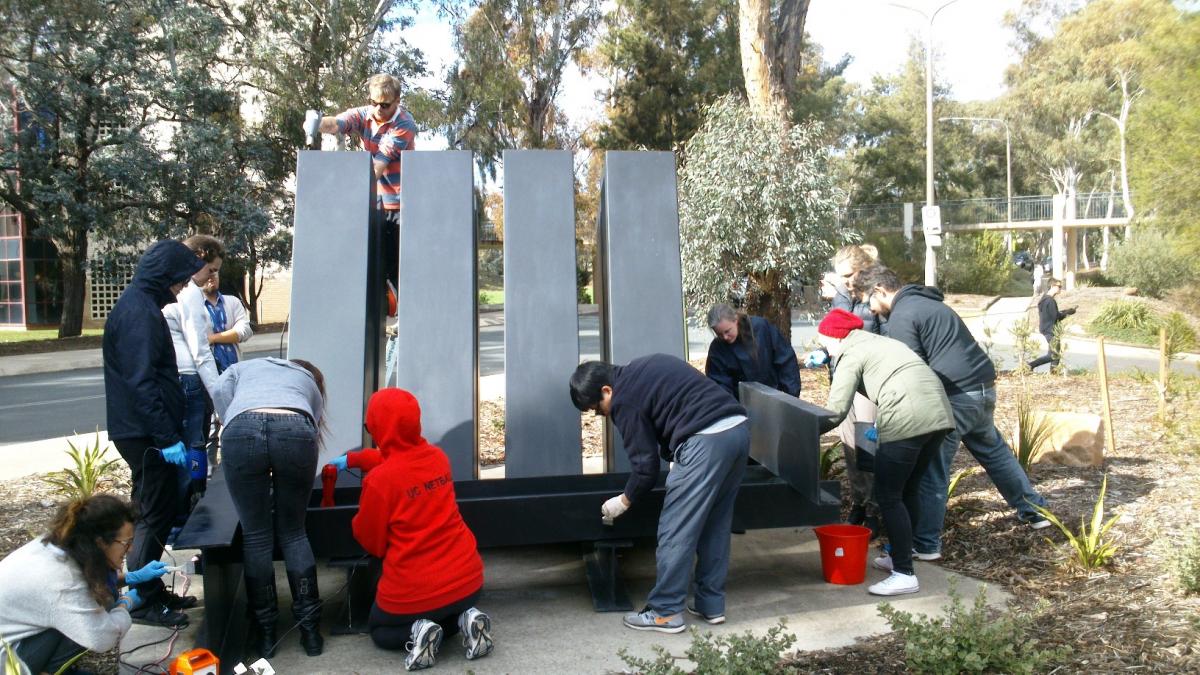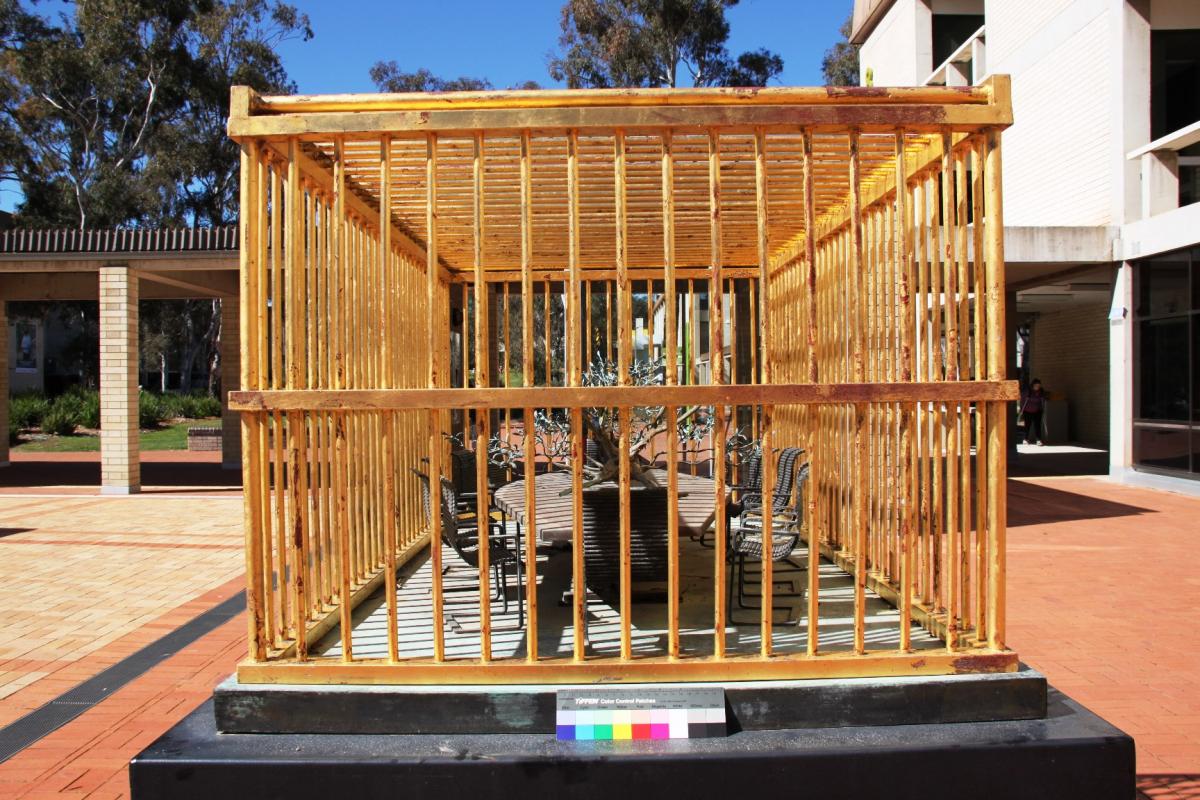For the past four years, Bachelor of Heritage Conservation students at the University of Canberra have been getting hands-on experience conserving sculptures on campus, under the supervision of Dr Mona Soleymani. The impetus for the conservation treatment of the UC sculptures began after work on a rare 1960s prefabricated plastic and fibreglass ‘Futuro House’ in 2012.

The distinctive flying saucer-style building was a feature of the old Canberra Planetarium, before it was donated to the University of Canberra by the Tradies Club in 2011.
The sculptures are generally located around the central area of the university and the Concourse. They have become popular campus landmarks, and architecture and cultural heritage staff are finding ways to involve them in their teaching and research. The UC outdoor sculptures treatment project stems from the recognition that outdoor sculpture is by its nature especially prone to damage and that conservation treatment on this category of objects is needed. Conservation of these works is especially challenging, given the uncontrolled, and often harsh, environments to which works are constantly exposed. Thus the treatment of these sculptures routinely involves major interventions that would be deemed drastic in other areas of conservation. The treatment project utilised background investigation by liaising with the UC Art Collection Manager to establish the most thorough and sound knowledge of materials and methods used to develop appropriate approaches for best practice in conservation.
So far, the heritage conservation students have worked on a number of sculptures including Reclining Figure by Ante Dabro (Figure 2),
 Katyusha by David Morris (Figure 3) and Gilded Cage by Alex Kosmas (Figures 4 & 5). The students have cleaned soot and other accumulated dirt from the exterior of the sculptures to enable further decisions to be made about the best way to conserve and protect them from elements of deterioration. Since its acquisition in 2007, Reclining Figure has not been cleaned and there was a green patina over some areas, indicating slight corrosion of the bronze, plus dirt, grime, spider webs and bird excrement. The treatment plan included cleaning with a little mild soap in water to loosen the dirt from the surface. As the object has a lot of nooks and crannies, different size paintbrushes were used for cleaning purposes.
Katyusha by David Morris (Figure 3) and Gilded Cage by Alex Kosmas (Figures 4 & 5). The students have cleaned soot and other accumulated dirt from the exterior of the sculptures to enable further decisions to be made about the best way to conserve and protect them from elements of deterioration. Since its acquisition in 2007, Reclining Figure has not been cleaned and there was a green patina over some areas, indicating slight corrosion of the bronze, plus dirt, grime, spider webs and bird excrement. The treatment plan included cleaning with a little mild soap in water to loosen the dirt from the surface. As the object has a lot of nooks and crannies, different size paintbrushes were used for cleaning purposes.  Once the sculpture was clean, it was wiped down with clean water to remove the soap residue. Then the sculpture was left to dry completely – this process was very important because the next step was to wax the sculpture and we did not want to trap moisture under the wax coating. Clean cotton rags were used to dry the sculpture as much as possible, followed by air-drying. Once the sculpture was completely dried, it was coated with a high temperature microcrystalline wax. This is usually done when the metal is warm and allows for the wax to enter the pores of the bronze. In this case, we used a number of hair dryers to melt the wax once it was applied on the surface of the sculpture. The wax acts as a barrier to air and humidity that can cause the oxidation process in bronze sculpture. The same technique was applied for the conservation treatment of Katyusha, which consists of steel beams covered with matt black paint.
Once the sculpture was clean, it was wiped down with clean water to remove the soap residue. Then the sculpture was left to dry completely – this process was very important because the next step was to wax the sculpture and we did not want to trap moisture under the wax coating. Clean cotton rags were used to dry the sculpture as much as possible, followed by air-drying. Once the sculpture was completely dried, it was coated with a high temperature microcrystalline wax. This is usually done when the metal is warm and allows for the wax to enter the pores of the bronze. In this case, we used a number of hair dryers to melt the wax once it was applied on the surface of the sculpture. The wax acts as a barrier to air and humidity that can cause the oxidation process in bronze sculpture. The same technique was applied for the conservation treatment of Katyusha, which consists of steel beams covered with matt black paint.  However, some areas of the black paint were examined before applying the wax to make sure the application of wax is safe.
However, some areas of the black paint were examined before applying the wax to make sure the application of wax is safe.
The treatment plan for Gilded Cage was much more complex. The cage itself is made of stainless steel and covered with gold leaf and the benches and table inside the cage are made of brass and bronze. The main problem with this sculpture is its current location, which is outside of the UC Library, where it is susceptible to light, chemicals, rainfall, wind, bird and insect attacks and vandalism. The sculpture had a number of flaked pigments in different parts of the cage, grime, dust, bird deposits, spider webs, and so on. The treatment plan included of two phases: the first stage, which was performed in October this year, was cleaning, stabilisation of the lifted pigments and retouching the missed gold pigments (exterior part). The conservation treatment project for the inside parts of the cage has been planned to be conducted next year as the cage itself is extremely heavy and needs a forklift to lift up the cage from the plinth.
As Gilded Cage has lots of chipping and flaking gold pigments in different parts of the cage, we decided to follow the dry cleaning method with the aid of soft bristled brushes. While the previous in-gilding were left untouched, lifted and fragile areas of the gilded surface were consolidated with Primal (Rhoplex) B-60A. Primal is an acrylic emulsion polymer widely useful as a binder for pigments in coating systems and it has good resistance to chemicals and grease, excellent pigment binding properties, good adhesion to most surfaces and high scrub resistance. For infilling and retouching, various gold pigments in Primal and also different shades of gold acrylic paints were tested on the missed and lifted gold pigment areas. We ended up with mixing different gold acrylic paints because they gave us the best results.
All in all, the sculpture treatment project proved to be very intensive with a lot of new challenges, giving the heritage conservation students a deeper understanding of the materials and techniques they need to consider. The students had the chance to learn and practice on the outdoor sculptures as part of their conservation units, which will help them to figure out problems and analyse risks that they might face when working on such objects.
Somayeh (Mona) Soleymani is the 2016 Donald Horne Postdoctoral Research Fellow in the Centre for Creative and Cultural Research at the University of Canberra. She is also a senior lecturer in the Heritage, Conservation and Museum studies program at UC where she was granted her PhD. Mona can be contacted at mona.soleymani@canberra.edu.au